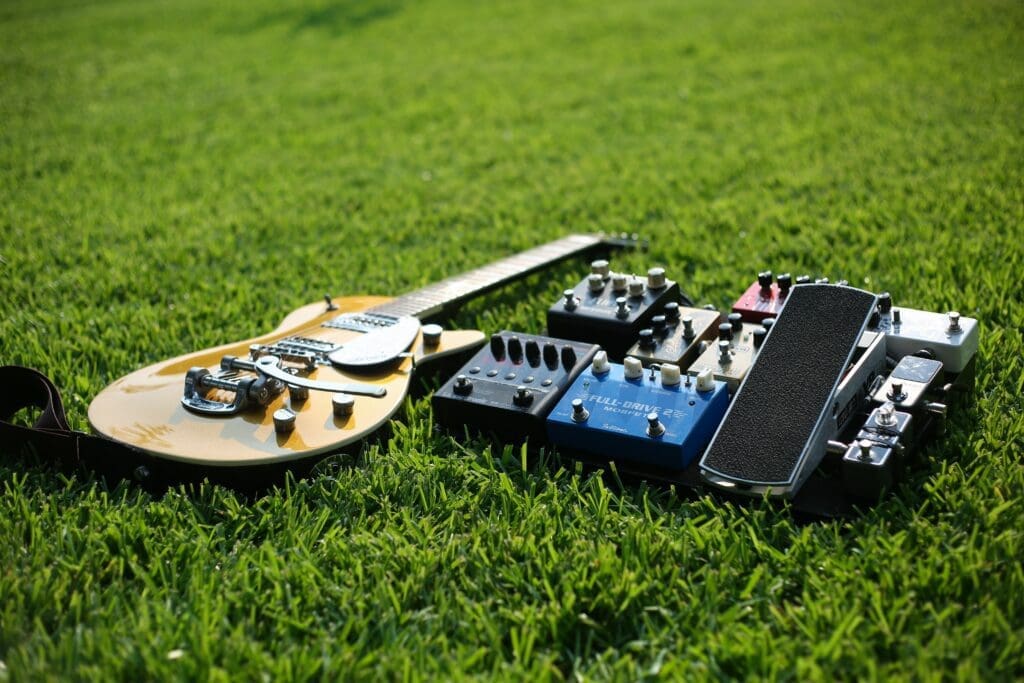
Wondering the best way to go about guitar tuning? Having played the guitar myself for nearly 13 years, I can, with full confidence, tell you that knowing how to tune a guitar properly is the most important skill to learn when mastering the instrument.
It doesn’t matter if you have the best guitar in the world, it won’t sound any good if it’s not in tune. In the following article, I’ll introduce you to the basics of guitar tuning, and help you get started on the right path to rockin’ your favourite tracks.
What Is Standard Guitar Tuning?
The good thing is that it isn’t actually difficult to tune the guitar.
The first thing you should understand is that there are actually several guitar string tunings, but the most common one is standard tuning.
Standard tuning was actually decided hundreds of years ago as a way to create a tuning that would ease transitions between simple chords and common scales – the more you know!
Like any tuning, standard tuning means that the guitar strings are tuned to specific pitches, starting from the thickest string (the low E string) to the thinnest one (the high E string).
The standard guitar tuning notes are E-A-D-G-B-e.
You can use this mnemonic to remember it in the future:
- E: Elephants
- A: And
- D: Donkeys
- G: Grow
- B: Big
- e: ears

Unconventional Guitars
Now, you might be wondering how standard tuning can be applied to more “unconventional” guitars, such as 7 string guitars, 12 string guitars or even baritone guitars.
Well, the 7 string guitar tuning process is very easy. All you need to do is tune the thickest string to “B”.
Therefore, the standard guitar tuning notes for a 7 string guitar are: B-E-A-D-G-B-e.
The 12 string guitar tuning process is even easier.
It’s common for most 12 string guitars to be tuned to the same standard tuning as a 6 string guitar, but each note comes in a pair of octaves.
The standard guitar tuning notes for a 7 string guitar are: EE-AA-DD-GG-BB-EE.
Baritone guitar tuning is a little bit trickier, as there isn’t really a standardised way of tuning it. However, the most common tuning for a baritone guitar is B to B, which is a perfect fifth lower than a standard guitar tuning. This means that the lowest string on a baritone guitar is B, and the highest string is B.
The “standard” guitar tuning notes for a baritone guitar are: B-F#-D-A-E-b.
Don’t worry, I see you there, Mr Bass Guitarist.
The convenient thing about the bass guitar tuning is that standard tuning applied, minus the last 2 strings of course!
The tuning order for standard tuning on a bass guitar is E-A-D-G.
You can use this mnemonic to remember it in the future:
- E: Elephants
- A: And
- D: Donkeys
- G: Grow
What are Alternate Tunings for Guitar?

Before we get into how you can tune your guitar, we should cover some over frequently encountered tunings and explore their unique characteristics.
- Drop D Tuning for guitar
Drop D tuning is one of the most popular alternate tunings for guitar and one that I use the most (next to standard tuning). To get into Drop D, the low E string is tuned down one whole step to a D, while the rest of the strings are tuned to standard tuning.
Drop D is great for metal, as it allows a much heavier sound than standard tuning (bands like Avenged Sevenfold use this tuning).
- Open G Tuning for guitar
In this tuning, the guitar is tuned to a G major chord (D-G-D-G-B-D). This tuning is used in many classic rock and blues songs and is used a lot in slide guitar playing (bands like Led Zeppelin used this tuning).
- Open D Tuning for guitar
Open D tuning is similar to Open G tuning, but the guitar is tuned to a D major chord (D-A-D-F#-A-D). This tuning is popular for slide guitar playing and is used in many blues and folk songs (bands like the Allman Brothers used this tuning). - Half-Step Down Tuning (E flat tuning) for guitar
In this tuning, all of the strings are tuned down one half-step (Eb-Ab-Db-Gb-Bb-Eb). This tuning is popular in grunge and alternative rock music and creates a darker, heavier sound great for electric guitar (bands like Motley Crue used this tuning). - Drop C Tuning for guitar
Dropped C tuning is similar to Drop D tuning, but the guitar is tuned down one whole step from Drop D (C-G-C-F-A-D). This tuning is popular in heavy metal music and creates a powerful, low-end sound (bands like System of a Down use this tuning).
What are the Methods of Tuning the Guitar?
Okay, so, now that you know the standard tuning order, the next question is how do you actually tune your guitar?
There are several methods you can use to tune your guitar, including using a clip-on tuner, using an app on your phone, or tuning by ear.
One of the easiest ways for a beginner to tune a guitar is by using a clip on tuner. These are small devices that you can clip onto the headstock guitar, and they help you get the exact pitch for each string. All you need to do is pluck the string, and the tuner will tell you if the string is too sharp, too flat, or just right.
This is the preferred way as Clip-on tuners are often more accurate than smartphone apps, as they are specifically designed for tuning instruments and can detect even the slightest deviations from the correct pitch.
Another super easy way to tune your guitar is, like I mentioned before, to download a free “guitar tuner” app. These apps work similarly to tuners, but they use the microphone on your phone to detect the pitch of the string.
I normally use a guitar tuning pedal attached to my pedalboard, but if I’m just noodling around, I’ll use the “guitartuna” iPhone app by Yousician.
The final way is to do it by ear. I’m not going to lie, this will definitely take you a while to learn – but it will come with practice.
To tune by ear, you load up a reference, such as a YouTube video or a piano and you match the pitch of the strings to the pitch of the reference.
How do you tune the guitar?
So, there are a few different methods of the guitar, but the way you tune it is actually the same across the board – and the video above is so good for a simple example for standard tuning.
Pluck the low E string (the thickest) and watch the tuner (or if you’re tuning by ear, match the pitch) to see if the needle moves to the left or right of the centre.
If the needle is to the left of centre, the string is flat, and you need to tighten it. If the needle is to the right of centre, the string is sharp, and you need to loosen it. Keep adjusting the string until the needle is centred.
Rinse and repeat for every string.
Once you have tuned all six strings, play a chord or scale to check your tuning. If any of the strings sound off, repeat the tuning process for that string until it is properly tuned.
How Do You Maintain a Properly Tuned Guitar?
We’ve covered standard tuning, alternate tunings, and different ways of tuning your guitar, but keeping your guitar in tune can be a challenge, especially if you’re new to playing. Here are a few tips for maintaining a properly tuned guitar:
- Use a quality tuner
Now, I know I mentioned a few different tips for tuning a guitar, but having a good tuner can save you a lot of time and hassle.
While there are many free tuning apps available for smartphones, investing in a quality tuner can make a big difference in the accuracy and stability of your tuning. A clip-on tuner is a great option as it allows you to tune your guitar hands-free, and they are usually more accurate than smartphone apps.
- Stretch your strings
New strings can take time to settle in, so it’s important to stretch them out before tuning. This can help to prevent your strings from slipping out of tune. To stretch your strings, simply pull them away from the fretboard with your fingers or a guitar pick, being careful not to pull too hard and damage them.
And don’t forget!
- Check your intonation
Intonation refers to the accuracy of the notes produced by each fret on your guitar. If your intonation is off, your guitar will never sound properly in tune, no matter how well you tune your strings. To check your intonation, play a note at the 12th fret and compare it to the harmonic at the same fret. If the note is out of tune, you may need to adjust the saddle on your guitar.
- Keep your guitar in a stable environment
Changes in temperature and humidity can cause your guitar to go out of tune. To maintain a properly tuned guitar, it’s important to keep your guitar in a stable environment, away from direct sunlight, extreme temperatures, and moisture. A guitar humidifier can help to maintain the proper humidity levels for your guitar.
- Check your tuning regularly
Even if you tune your guitar regularly, it’s still a good idea to check your tuning periodically throughout your playing session. This can help you catch any subtle changes in tuning before they become noticeable to your audience.
Troubleshooting Common Tuning Problems

It’s pretty frustrating when your guitar won’t stay in tune. Fortunately, most common tuning problems can be easily resolved with a little troubleshooting.
- Problem 1: Strings Won’t Stay in Tune
If your guitar strings won’t stay in tune, it’s likely due to stretching or slipping. To fix this problem, you can try stretching your strings before tuning by gently pulling on each string. You can also check the tuning pegs to make sure they are tightened properly.
- Problem 2: Intonation is Off
As I mentioned earlier, intonation is the accuracy of the notes produced by each fret on your guitar. If your intonation is off, your guitar will never sound properly in tune, no matter how well you tune your strings. To fix this problem, you can adjust the saddle on your guitar. To check your intonation, play a note at the 12th fret and compare it to the harmonic at the same fret.
Settling and Storage
Just note, if you’ve just replaced your strings, then they will take a while to settle. This means that you’ll have to retune your guitar a few times before the tuning sticks.
- Problem 3: Guitar is Out of Tune with Other Instruments
If your guitar is out of tune with other instruments, it’s likely due to differences in tuning systems or tuning variations. To fix this problem, you can try tuning to a different reference note or using a different tuning system. You can also try using an electronic tuner that can adjust to different tuning systems.
- Problem 4: Guitar Won’t Stay in Tune for Long
If your guitar won’t stay in tune for long, it’s likely due to changes in temperature, humidity, or playing conditions. To fix this problem, you can try keeping your guitar in a stable environment, away from direct sunlight, extreme temperatures, and moisture. You can also try using a guitar humidifier to maintain the proper humidity levels for your guitar.
Closing Thoughts on Guitar Tuning
Guitar tuning is an important part of playing guitar and can make a huge difference in your sound. With a little practice and patience, you can learn to tune your guitar accurately and quickly. With the right tuning, you can take your playing to the next level and really get the most out of your instrument.










